Why Proper Morgue Refrigeration is Critical for Modern Facilities
A morgue freezer is a specialized refrigeration system designed to preserve deceased individuals at sub-zero temperatures, typically ranging from -10°C to -50°C (-14°F to -58°F), to halt decomposition for extended storage.
Key morgue freezer specifications:
- Temperature range: -10°C to -50°C (-14°F to -58°F)
- Types: Walk-in units, body box systems, mobile units
- Capacity: 1-50+ bodies depending on configuration
- Materials: Stainless steel construction with high R-value insulation
- Compliance: NSF certified, OSHA compliant safety features
- Applications: Forensic facilities, hospitals, funeral homes, disaster response
Morgue freezers are essential for storing bodies for weeks or months for forensic investigation, identification, or emergency situations. Unlike morgue refrigerators that only slow decomposition at 2°C to 4°C, freezers completely halt the process.
The choice between refrigeration and freezing depends on storage duration and purpose. Refrigeration is used for short-term storage (autopsy, funeral prep), while freezing is required for long-term storage (forensic cases, mass casualty events, delayed identification).
Modern morgue freezers offer modular designs, advanced monitoring, and custom features. Understanding freezer types, capacity, and regulatory standards is key to selecting the right solution for a new facility or an upgrade.
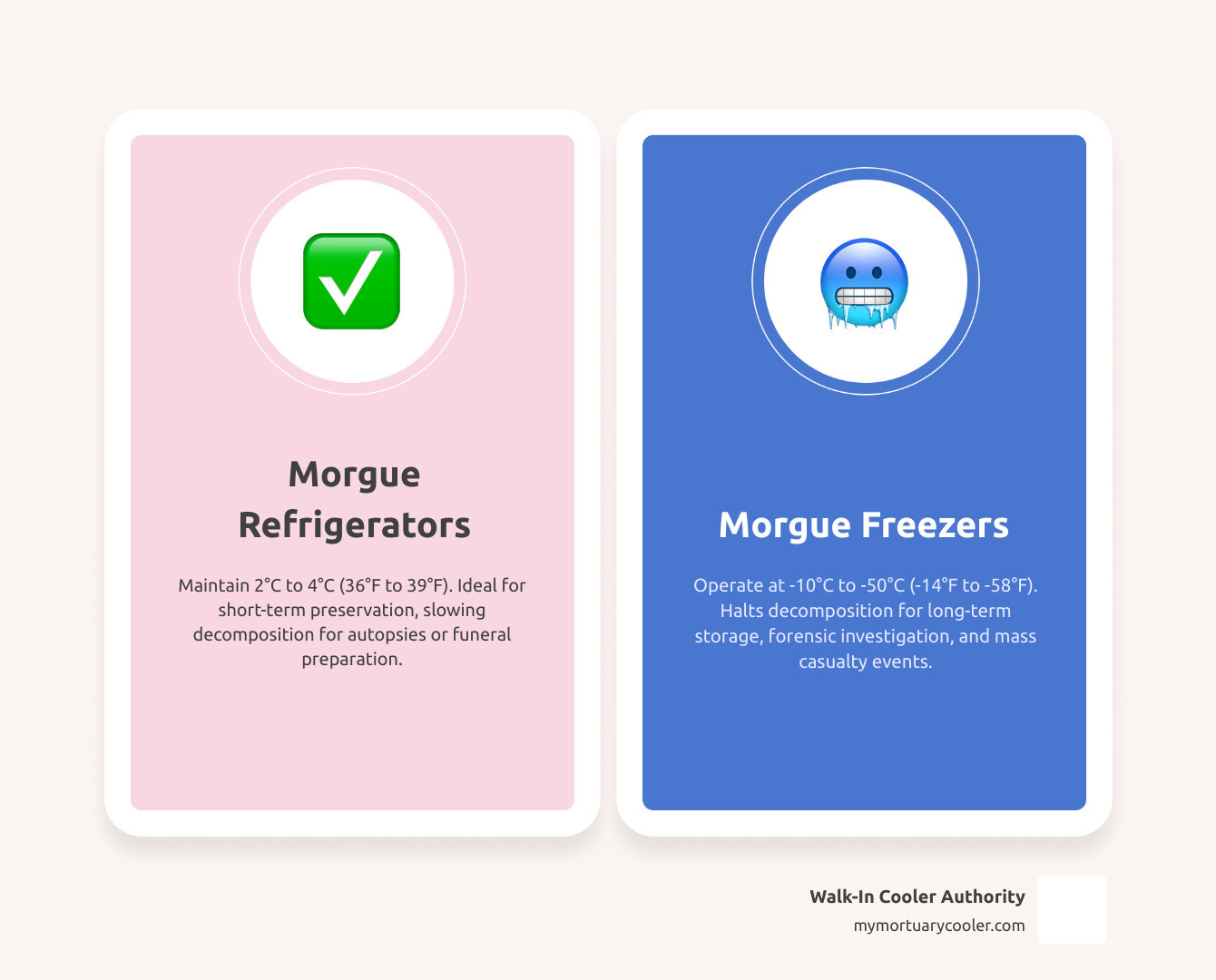
The Essential Role of Morgue Freezers in Modern Facilities
Morgue freezers are critical pieces of equipment in hospitals, funeral homes, and forensic labs, serving purposes that extend beyond simple cold storage. They are essential for preserving dignity, aiding scientific investigation, and protecting public health.
The primary role is decomposition prevention. By maintaining sub-zero temperatures, a morgue freezer halts biological processes, providing necessary time for families and professionals.
Preservation for identification is crucial after accidents, disasters, or in complex forensic cases. The freezer maintains physical characteristics, helping specialists provide closure to families.
For autopsy preparation, pathologists require optimal body conditions to determine cause of death. Similarly, organ transplant preservation needs precise temperature control to keep organs viable.
Hygiene and safety standards are non-negotiable. Modern morgue freezers have features like seamless interiors and antimicrobial surfaces to prevent contamination. OSHA compliance is essential for protecting staff.
Most importantly, morgue freezers enable dignified handling of the deceased, giving families time for arrangements and allowing for thorough legal investigations. For more info about mortuary equipment, you can explore our comprehensive buyer's guide.
Positive vs. Negative Temperature Storage
Positive and negative temperature storage serve very different purposes, and understanding the distinction is crucial for any facility.
Positive temperature storage uses refrigeration units at 2°C to 4°C (36°F to 39°F). These morgue refrigerators slow decomposition for short-term storage—typically a few days to a couple of weeks. Most hospitals and funeral homes rely on these units for routine operations like awaiting autopsy or funeral services.
Negative temperature storage is where true morgue freezers operate, at -10°C to -50°C (-14°F to -58°F). These units completely halt decomposition and are designed for long-term storage and forensic use. When evidence must be preserved for months or mass casualty events occur, freezing is the only viable option, as it completely stops the cellular breakdown that continues in refrigeration.
The choice between refrigeration and freezing comes down to storage duration and the required condition of the body. Our detailed comparison in Morgue Freezer vs. Morgue Refrigerator: Essential Insights can help you make the right decision.
Ensuring Hygiene and Safety
Modern morgue freezers are designed with meticulous attention to hygiene and safety.
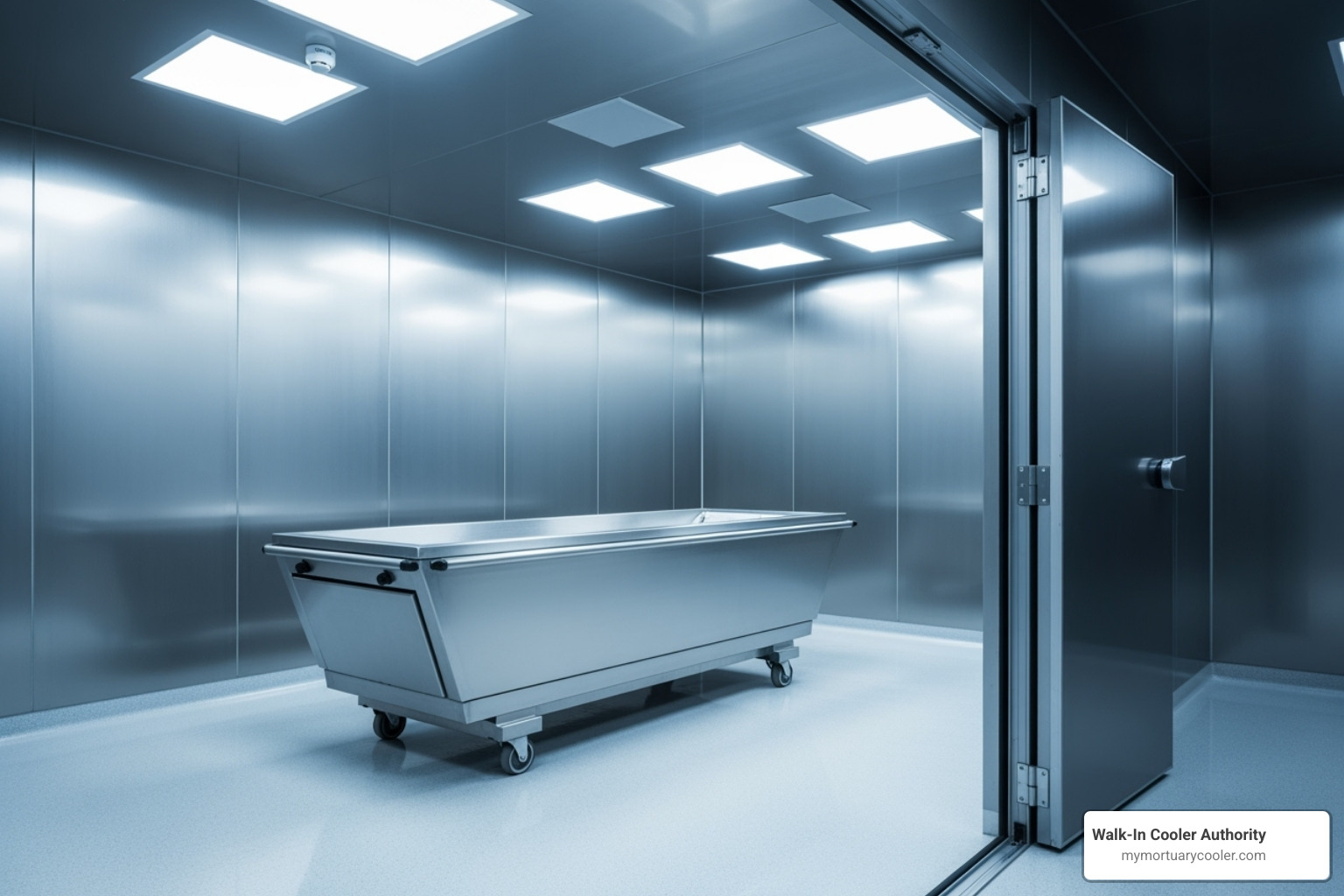
Stainless steel construction (Grade 304) is standard due to its non-porous surface that resists bacteria and simplifies sterilization. Some manufacturers offer advanced Sanisteel™ finishes for additional anti-microbial properties and resistance to scratches and corrosion.
A seamless design, found in quality units, eliminates cracks and crevices where bacteria can hide, making thorough cleaning possible.
Vapor-proof lighting is a crucial safety feature. These sealed fixtures prevent moisture from reaching electrical components and provide clear visibility for staff.
The most important safety feature is the OSHA-compliant safety release on every door, allowing anyone accidentally trapped inside to exit easily.
These elements work together to prevent cross-contamination and ensure sanitation is integral to the design, which is essential when handling biological materials.
Choosing the Right Morgue Freezer: Key Specifications and Features
Selecting a morgue freezer requires careful consideration of your facility's specific needs to ensure optimal daily operations.
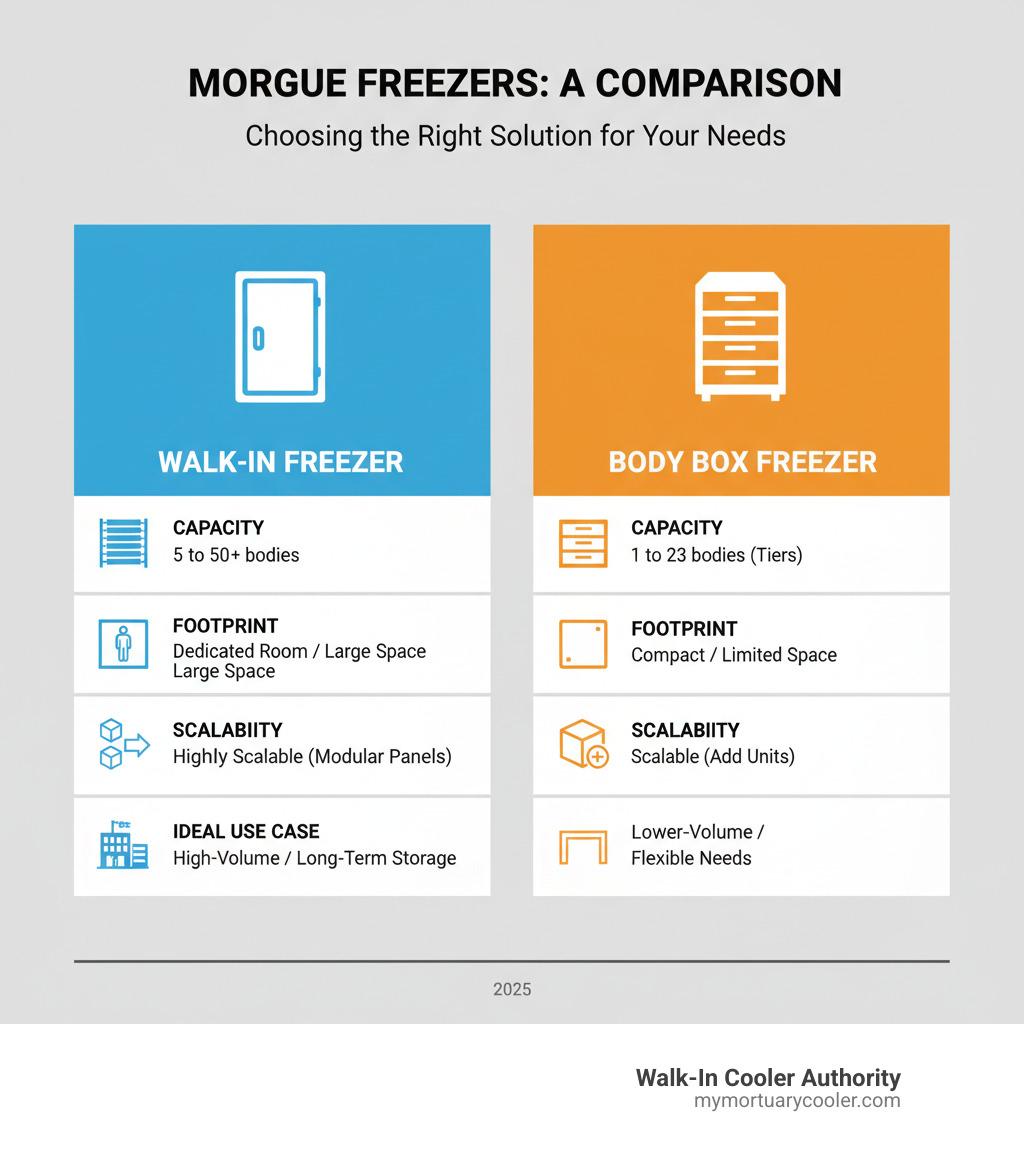
| Feature | Walk-In Morgue Freezer | Body Box Morgue Freezer |
|---|---|---|
| Capacity | 5 to 50+ bodies (with rack systems) | 1 to 23 bodies (depending on tiers) |
| Footprint | Requires dedicated room/larger space | Compact, stackable, suitable for limited space |
| Scalability | Highly scalable with modular panels | Scalable by adding more individual units |
| Ideal Use Case | High-volume facilities, long-term storage, disaster preparedness | Smaller facilities, labs, temporary overflow, specific case storage |
Your capacity needs are the foundation of this decision. A small funeral home has different requirements than a large hospital. Walk-in units handle 5 to 50+ bodies, while body box units accommodate 1 to 23.
Space efficiency is often a deciding factor. Modular designs are highly beneficial, as they can be configured to fit almost any space, maximizing the available area.
Don't overlook energy costs. A morgue freezer runs 24/7, so efficiency is key. Modern units with high R-value insulation and smart controls can significantly reduce power consumption. For detailed guidance, check out The Complete Guide to Choosing the Right Freezer Room.
Types of Morgue Freezers
Morgue freezer systems come in several types, each designed for specific storage challenges.
Walk-in freezers are ideal for high-capacity facilities like hospitals and forensic institutes. Built from modular, insulated panels, they can be assembled, moved, and reconfigured. Their flexible interior layout can be customized with various rack systems to maximize space.
Body box units are compact, self-contained cabinets holding 1 to 23 bodies. Available in 2, 3, and 4-tier configurations with various loading designs, they are ideal for smaller facilities or as supplementary storage.
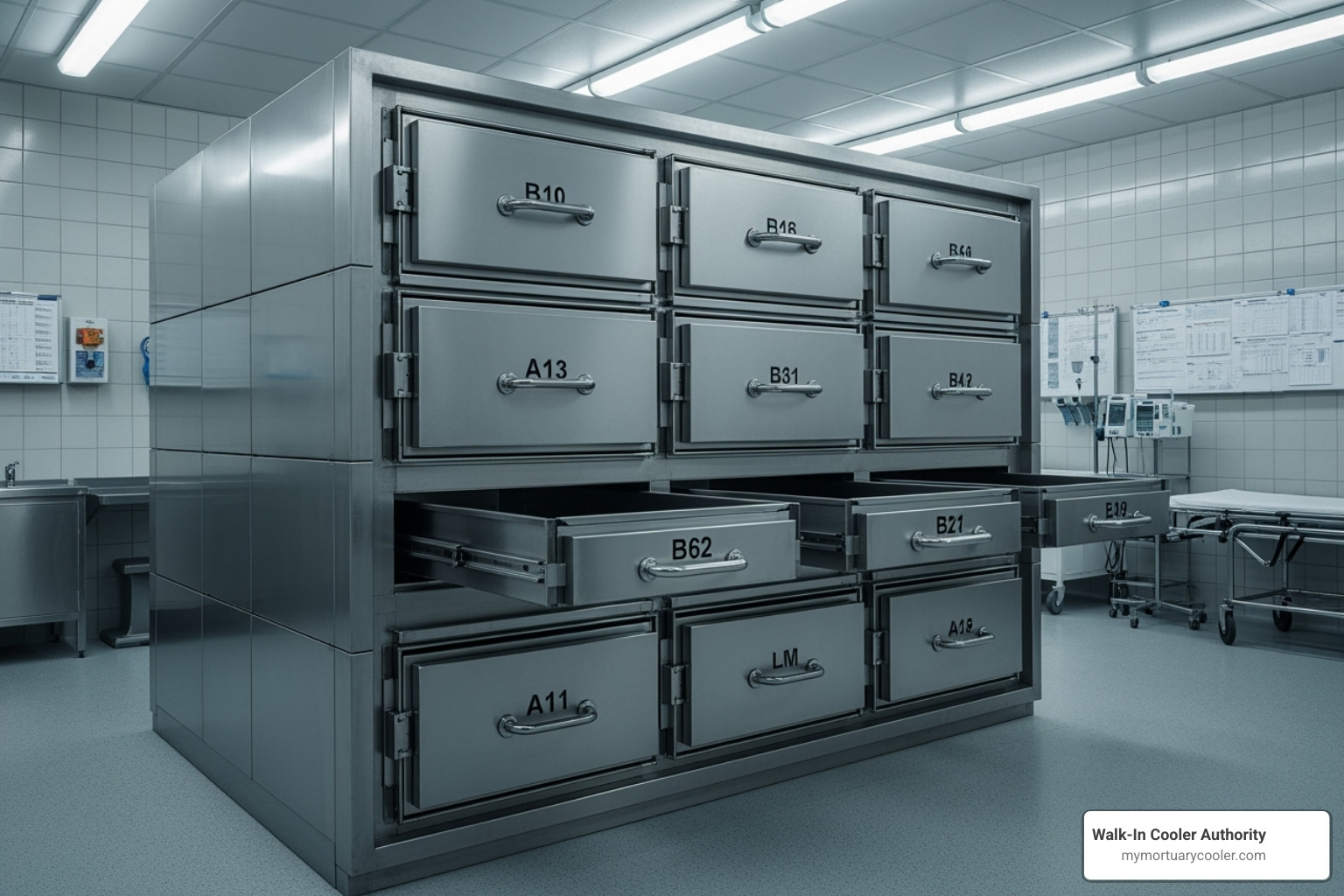
Mobile freezers are trailer or skid-mounted units that provide maximum flexibility. They can be deployed for temporary storage during disaster response or to handle seasonal capacity fluctuations.
The modular design of many systems is key for scalability. It allows you to add modules for more storage or relocate the entire unit, ensuring your investment adapts to your facility's changing needs. For more insights, explore Commercial Walk-In Freezers That Are Cooler Than Cool.
Critical Features and Materials
The features and materials of a morgue freezer are the foundation of reliable, safe, and efficient preservation.
A consistent temperature range of -10°C to -50°C (-14°F to -58°F) is non-negotiable to halt decomposition. Modern digital controls with microprocessor-based PID systems and LED displays ensure precision and simple monitoring.
High R-value insulation keeps temperatures stable and energy bills low. Quality units use 4-inch thick panels with high-density polyurethane foam for an effective thermal barrier, ensuring both efficiency and reliability.
The construction materials determine durability and hygiene. Stainless steel interiors (304-grade) offer corrosion resistance and easy cleaning. Some units have seamless fiberglass construction to eliminate hiding spots for bacteria. Freezer panels are robust, modular, metal-clad insulated panels that allow for flexible installation and relocation.
Digital controls and alarm systems provide early warnings. High/low temperature alarms with audio/visual alerts are critical. Features like heated door jambs, magnetic gaskets, and automatic door closers maintain the seal and improve energy efficiency. For detailed guidance, visit A Practical Guide to Choosing the Right Freezer Panels.
Customization and Advanced Technology
Modern morgue freezer systems are sophisticated, customizable solutions that adapt to your facility's specific workflow.
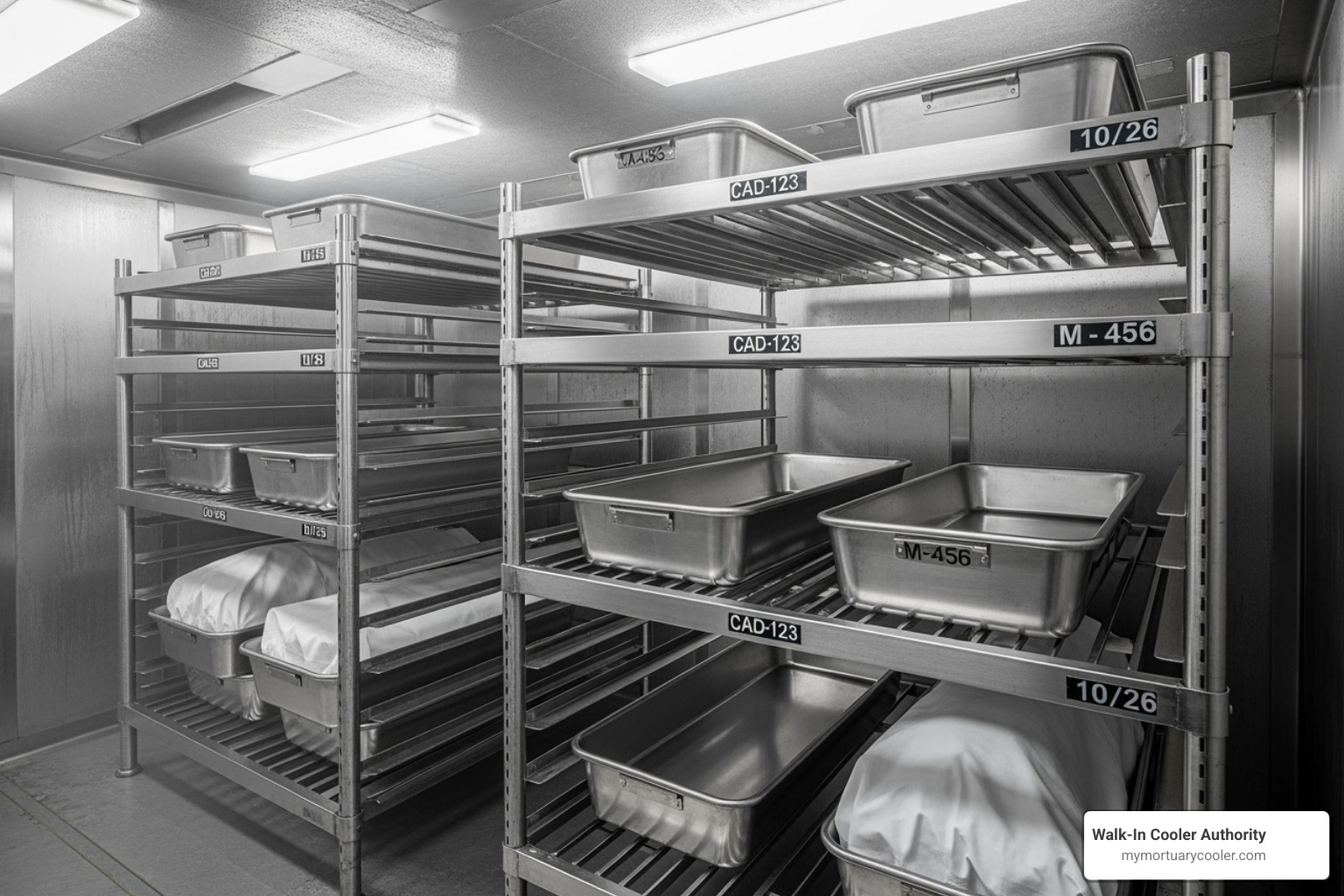
Customization options optimize your storage system. Adjustable shelving and racking can accommodate standard and bariatric storage. Roll-in cart compatibility streamlines transfers and reduces manual handling. Exterior finishes can be color-matched to your facility.
Door configurations are also customizable. Choose from sliding, manual, electric, bi-parting, lift-up, or roll-up insulated doors based on your space and workflow.
Advanced technology integration includes remote temperature monitoring for 24/7 oversight with automated alerts. Building management system integration allows for centralized control.
For critical applications, refrigeration redundancy ensures continuous operation if a primary system fails. A2L compliant refrigeration systems meet the latest environmental standards.
American-made quality provides superior craftsmanship, rigorous quality control, and readily available parts and support. This means less downtime and more reliable service. Learn more at USA Made Walk-In Coolers, Freezers.
Installation, Maintenance, and Regulatory Standards
Investing in a morgue freezer is a long-term commitment. Proper installation, maintenance, and regulatory compliance are crucial from the start to ensure reliable, long-term service and avoid future issues.
Getting Your Installation Right
A successful morgue freezer operation starts with proper site preparation. Ensure the location can handle the unit's weight and that the electrical infrastructure has adequate power and proper drainage. Modern systems feature modular panel construction, which simplifies assembly and provides future flexibility for relocation or expansion.
We strongly recommend professional installation. Morgue freezer refrigeration systems require precise calibration for efficiency. Professional setup ensures correct configuration, leading to better performance and lower energy costs.
Keeping Your Investment Running Smoothly
Regular maintenance for your morgue freezer is crucial. It prevents small issues from becoming expensive problems and significantly extends the equipment's life. We offer comprehensive service and support programs to simplify maintenance. Our planned maintenance programs provide scheduled professional attention, and our expert technicians are available for immediate assistance. For more guidance, check out The Definitive Guide to Mortuary Freezer Suppliers.
Understanding Your Morgue Freezer Maintenance Needs
A consistent maintenance routine for your morgue freezer is key. Know what to check at daily, monthly, and quarterly intervals.
- Daily and weekly checks should include monitoring temperature displays, visually inspecting door seals, and listening for unusual noises or vibrations.
- Monthly maintenance involves cleaning exterior and interior surfaces with appropriate disinfectants and testing all temperature and door alarms.
- Quarterly and bi-annual maintenance includes critical preventive work. Gasket inspection is vital to prevent cold air leaks. Condenser cleaning is equally important to prevent system strain and potential compressor failure.
Temperature calibration by a qualified technician is crucial to ensure sensors are accurate and maintaining precise conditions. This is not a DIY job. Service contracts are a wise investment for busy facilities, ensuring regular professional maintenance and priority response. For additional regulatory guidance, you can reference information on building codes from relevant authorities.
Meeting Certification and Regulatory Requirements
Understanding the regulatory landscape for morgue freezer operations is essential for safe and legal operation. Compliance with these standards, which protect staff and the public, is non-negotiable.
NSF approval is the gold standard for sanitation and safety. Our NSF-certified coolers and freezers have undergone rigorous testing for hygiene, cleanability, and material safety, ensuring they meet the highest professional standards.
OSHA standards focus on employee protection. The most visible requirement is the safety release handle on freezer doors to prevent accidental entrapment. Our OSHA-compliant units prioritize worker safety.
Local health codes vary by location and may have specific rules for ventilation, waste disposal, or monitoring. Consult local authorities early in your planning process.
Building permits and electrical codes are also required. Installing a walk-in morgue freezer typically requires permits for structural and fire safety. All electrical work must meet local codes for safety and performance.
Frequently Asked Questions about Morgue Freezers
When facilities are considering a morgue freezer investment, questions naturally arise. Here are answers to the most common questions we hear from our clients.
When is expanding morgue freezer capacity a good option?
Expanding your morgue freezer capacity is often about responding to unexpected events with dignity and professionalism, not just planning for steady growth.
Emergency situations like natural disasters, pandemics, or mass casualty events can quickly overwhelm a facility's capacity. Having flexible solutions ready is critical to maintaining professional operations. Facility renovations may also take existing storage offline, requiring temporary capacity.
Other reasons for expansion include predictable peak demand periods and disaster response preparedness. Modern mortuary refrigeration is flexible. Temporary overflow solutions like mobile units or additional body box freezers can be deployed quickly. At Walk-In Cooler Authority, we provide solutions for all these scenarios.
What is the typical capacity of a morgue freezer?
The required capacity of a morgue freezer depends entirely on your facility's unique needs.
Body box capacity is ideal for smaller facilities, handling 1 to 23 bodies. These versatile systems come in 2, 3, or 4-tier arrangements to maximize vertical space.
Walk-in capacity systems can accommodate 5 to 50+ bodies. The exact number depends on the interior rack configuration, with specialized tiered racking systems significantly increasing storage density.
Bariatric options are available to ensure dignified storage for individuals of all sizes, though they require more space per person. It's wise to consider future needs; starting with a moderate capacity with available expansion options provides flexibility.
How much does a morgue freezer cost?
Budget is a crucial factor when purchasing a morgue freezer. Several factors influence the final cost.
- Size is the biggest cost factor. A small body box unit costs less than a large walk-in system.
- Type differences also matter. Walk-in systems are a larger investment than body box units. Mobile freezers offer portability for temporary needs.
- Features and customization impact the price. Adding remote monitoring, antimicrobial surfaces, or custom shelving increases the investment over a basic model.
- Installation requirements, such as site preparation and electrical work, can add significantly to the total investment.
Quality morgue freezer equipment is built to last for decades with proper maintenance, making the long-term operating cost reasonable. For a detailed breakdown, check out The Complete Guide to Commercial Walk-In Freezer Cost. We recommend getting a customized quote for an accurate picture of your investment.
Conclusion
Choosing the right morgue freezer is a critical decision for your facility. Understanding the details of preservation science, equipment types, and regulatory compliance is key to making the best choice.
The key takeaway is that morgue freezers are vital for more than cold storage. Positive temperature refrigeration (2°C to 4°C) is for short-term use, while negative temperature freezing (-10°C to -50°C) is for long-term preservation, identification, and forensic investigation.
Reliability and durability are top priorities. Look for stainless steel construction, high R-value insulation, and seamless designs. Essential features like OSHA-compliant safety releases and anti-microbial finishes protect staff and ensure high standards.
Your capacity needs may change. Walk-in freezers offer scalability, while body box units are efficient for smaller spaces. Also, plan for temporary needs during emergencies.
Compliance with NSF, OSHA, and local health codes is mandatory. Regular maintenance is crucial to prevent breakdowns when you need your morgue freezer most.
At Walk-In Cooler Authority, we are America's trusted authority in the mortuary industry. We offer direct sales on OSHA-compliant mortuary refrigeration, helping professionals save money without sacrificing quality.
Our American-made quality ensures superior craftsmanship and support. We are here to help you make an informed decision for your new or existing facility.
Ready to explore your options? Become a body freezer authority with our mortuary and cadaver freezers and find how the right equipment can make all the difference in your daily operations.
















